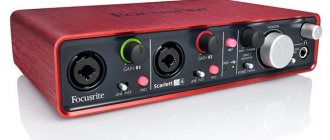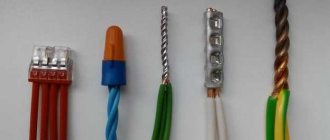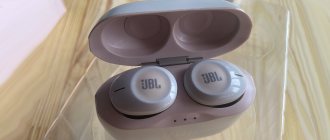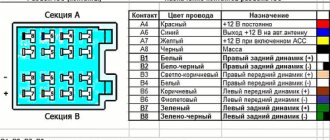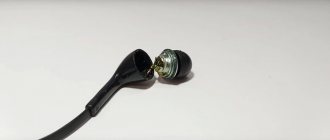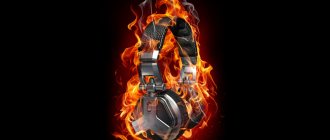Modern audio equipment reproduces the entire required frequency range. This factor is sufficient to listen to music, but there is no effect of the listener's presence at the concert. Purchasing a horn for your car will correct what was lost and provide high-quality sound. Horn acoustics have a simple design - a small speaker is connected to a horn, which significantly increases the sound volume. But you need to pay special attention to a number of factors - the correct choice of a tweeter from a suitable material, installation features and device connections.
FIXED HORN SUBWOOFERWhat are T/S (Tiel Smol) parameters and how will they help me choose the most suitable speaker for my conditions???? And so what lies behind the parameters of Thiel Small. To begin with, I will give you a description of the most common (useful) T/S (Tiel Small) parameters, and below I will explain how you can use them to select the most suitable speaker for your speaker system. The explanation will be simple; I will not delve into the mathematical and mechanical nuances of these parameters, so that everything would be clear even to a beginner.
fs: Driver free air resonance. fs: the main resonance of the dynamic head (also called resonance in the open air - without registration
We can say that these are the conditions under which all moving parts of a dynamic system are synchronized or enter into resonance. Resonance is quite difficult to explain; it is easier to understand this phenomenon if we simply say that it is very difficult to obtain a frequency using a speaker below the frequency of its main resonance.
For example, roughly speaking, a speaker with a fundamental resonance frequency (fs: Driver free air resonance) = 60 Hz will not reproduce a frequency of 35 Hz very well.
A speaker with a fundamental resonance frequency (fs: Driver free air resonance) = 32 Hz will reproduce a frequency of 35 Hz quite confidently if your acoustic design is configured to reproduce such low frequencies. These two explanations are very suitable for choosing a speaker for the design of FI (phasin reverter), ZY (Closed Box) and band-pass (band pass). In the case of a horn subwoofer, this parameter is not so critical, since there the speaker is rather used as a piston, and the frequency is created by the very design of the subwoofer in the form of a horn.
Qts: Driver total Q. Qts: Total speaker quality factor
Sometimes the letter Q is omitted in this parameter, since it is an abbreviation of the word (quality - goodness). So Qts is the overall quality factor of the speaker, which includes electrical and mechanical quality factors. Qts - lets us understand how strong the motor (magnetic) system of the speaker is. Speakers with a low overall system quality factor (about 0.20) will have a large magnet and will be able to move the speaker cone with great force. This is done for tight (rigid) speakers. Speakers with Qts = 0.45 will have a smaller magnet and correspondingly less force for movement of the cone. So a low Qts gives a strong (hard, dense) and sharp sound, but with a light weight or low bass and a large Qts the result is a long and strong sound that gives you a lot of low-frequency pressure. Beware of speakers with a large Qts, more than 0 6. For normal operation of such speakers you will need huge acoustic designs (boxes), since with normal (really reasonable) sizes of acoustic design you will not get much bass component from these speakers. It is better to use such speakers in the rear window of your car, where they will get a lot of free space behind their back.
Qms: Driver mechanical Q Qms: Mechanical quality factor of the speaker
Qms is the mechanical quality factor of the speaker, gives an idea of all the mechanical parameters of the speaker together. This is an expression of the control created by the rigidity of the suspension.
Qts (total quality factor of the speaker) consists of electrical quality factor Q (Qes) and mechanical quality factor Q (Qms)
Qts can be calculated as 1/Qts = 1/Qes + 1/Qms
Qms is calculated as
Fs sqrt(Rc) Qms = ——————- f2 — f1 A speaker with a high mechanical quality factor Qms can play more openly, cleaner and have a larger dynamic range. Because such speakers will have lower losses. A rubber surround is more flexible, a paper surround, which is part of a diffuser, is more structural, they have greater air flow and usually correspondingly greater sensitivity. Thus, mechanical quality factor is a very good indicator of the speaker's energy reserves.
Qts is just the product of Qes and Qms, and understanding what these values mean is very important when designing speaker systems. Qts Vas and fs are all you need to calculate the dimensions of your future acoustic design (box), over time, when you move to a more professional level of design, values such as Qes and Qms will become necessary for you for subsequent work.
BL: Driver motor strength. BL: Speaker Magnetic Strength
BL: The higher this value, the stronger the motor (magnetic system). Speakers with a high BL level (30 or more) can control their own cone very clearly. Typically these speakers have very large magnets and weigh a lot. Please note that speakers with a high BL level usually have a low Qts value - overall quality factor. Speakers with low BL values (20 or less) control their cone less tightly. These speakers will not be as stiff (tight) as their counterparts. They will in most cases have a large Qts value (more than 0.28). I call these speakers “mud speakers” because of their long and spacious bass with rather poor immediate response.
Vas: Volume of air equal to the driver compliance. Vas: Equivalent speaker volume
It gives an idea of how tight the speaker’s suspension is. The value is given in liters or cubic inches. There are many parameters that affect the Equivalent Volume, so we cannot say that a large value for the Vas parameter is better. The equivalent volume is affected by the speaker suspension, the size of the diffuser, and even the air temperature. This is the most difficult parameter to determine. Its significance is the most difficult to assess.
Mmd: Mass or weight of the speaker cone assembly. Mmd: Mass or weight of the moving speaker system
Expresses how heavy the cone, coil and other moving parts are. An 18-inch speaker with a Mmd of about 100 grams will have a fairly light cone and will be more efficient than speakers with heavier cones. A light diffuser moves faster. A lightweight diffuser also has a large Qts, but not always. This gives them the advantage of instant response; the lighter the diffuser, the faster the response, but a weak speaker motor can affect the increase in the overall quality factor of the Qts speaker, which compensates for all the advantages of a light diffuser. Speakers with Mmd greater than 200 grams will have heavy cones. They are usually less productive (low efficiency), have double baskets and low Qts. Speakers with heavy cones have a slower sound, but do not always have low Qts and high BL. The motor power of a dynamic system can counteract the weight of a heavy diffuser and produce quick response and greater efficiency. Don't confuse Mmd and Mms. Mms is the total weight of the speaker assembly. Some programs want you to enter Mmd and use it to calculate Mms, others do the opposite.
Sd: Effective driver radiating area. Sd: Effective speaker cone area.
Given in square centimeters. Usually means how large the area of the speaker is that it moves air. Large speakers have a large area, while small speakers have a small area. The standard cone area for an 18-inch speaker is 1150 square centimeters, and a 15-inch speaker has an area of about 890 square centimeters. True, the depth of the diffuser is often also taken into account. A deeper diffuser will give a larger diffuser area with the same diameter. This is why you see different effective areas of speakers of the same diameter. Those that have a larger effective area are usually either deeper or have less suspension, which increases their effective area.
xmax: The amount of voice coil overhang. xmax: Cone (voice coil) shift in millimeters
Reflects the distance in millimeters that the coil travels, from the farthest point to the lowest point relative to the magnet. Speakers with xmax 10 mm can move the cone twice as far as speakers with xmax =5. Do not confuse xmax with maximum excursion (maximum diffuser extension). maximum excursion — the maximum extension of the diffuser can be characterized in two ways: 1. extending the diffuser back until the coil rests on the magnet 2. extending the diffuser forward until it is stopped by the maximum possible bend of the suspension. xmax is the distance that the coil can travel while in the magnetic field of the speaker. There is no point in extending the coil outside the speaker's magnetic field, because outside the field the coil will be out of control of the speaker's motor. A larger xmax value means that the coil can move forward and backward quite far while being under the control of the dynamic system motor (magnetic field) all the time. Please note that an xmax value of 5 mm means that the diffuser (coil) can move 5 mm forward and 5 mm backward under the control of the dynamic system motor.
Vd: Displacement volume. Vd: Shift volume (verbatim)
This value is often used by those who have a big appetite for speakers larger than 24 inches. Vd is Sd multiplied by xmax. This value can be thought of as the amount of air that can move the speaker in one pass. I have described this parameter below Sd and xmax precisely because they are both included in this value. Basically, in order to create the sound pressure you need, you have to move the air, and the lower the frequency you want to reproduce, the more air you have to move. You can do this with a larger cone that has a larger effective cone area, or you can do it with a smaller speaker that can move back and forth a greater distance (have a larger xmax). So, an 18-inch speaker with an effective cone area of 1150 square centimeters and xmax 5 mm can move 5750 cubic centimeters of air at a time. You can think of it as a fan that has a lot of air in front of it, and when you move it quickly it will direct this air towards you, very quickly and with a constant rhythm - this is the speaker. Now let's take the Precision Devices PD 1850 speaker as an example, it has 11.25 mm xmax and an effective area Sd of 1150 square centimeters. Its Vd will be equal to 12,975 cubic centimeters. He pushes 12,975 cubic centimeters of air onto someone, which is much more painful (stronger) than 5,750 cubic centimeters. Some people have noticed that 12,975cc is almost twice as much as 5750, which is why I prefer to work with speakers like the PD 1850. Comparing Vd values is very useful to understand how much bass a speaker can reproduce, and many people simply do not know this.
no: Free air reference efficiency. no: Speaker performance in open air (roughly speaking)
The value is given as a percentage. I found it more useful than the sensitivity that the developers indicate. Many sensitivity values are deliberately inflated by the developers, some developers do not even indicate no, they only give the sensitivity value. no is the sensitivity of the speaker before the developers plugged it into the box and measured the values that were correct for this speaker in their opinion. For bass speakers, no 3.8% to 5% is a very very good indicator; a speaker usually with such parameters will have a sensitivity of 97.9 to 99 (dB)dB. Most often, speakers are found with no of about 1.8 - 3.8% and these speakers will be less efficient. And speakers with no = 1.8% will give a sensitivity of 94.7 (dB) dB and 3.8% - 97. 9 (dB)dB. Values are given in 1W/1m (1 Watt/1 meter). As a rule, speakers with a large xmax have a small no value. Because they have long coils that are too heavy for the speaker motor to move with such sensitivity. Therefore, you will have to invest additionally in an amplifier that will drive such a speaker, or take a speaker with greater sensitivity and at the same time save on the amplifier. You will never get as much power from a speaker with a small xmax compared to what you can get from a speaker with a large xmax, but you will always get the maximum possible at a given power from a speaker with more sensitivity and a small xmax. If you never drive your speakers seriously then use sensitive drivers, drivers with low xmax values will usually save you money on purchasing the speaker itself in the first place, and they also require less powerful amplifiers to get the most out of these types of speakers. You will also benefit from light weight. If you drive your speakers seriously and want maximum performance from them in the acoustic design (sizes you have calculated), then you need to use speakers with long coils and that have a large cone throw. Also, you will need a serious budget for amplifiers; usually it takes more than a kilowatt to reach their maximum reach, due to the lack of sensitivity. If I have 500 - 750 watts to spare per speaker, then I will use more sensitive speakers, with a small xmax. If in this case you are using low-sensitive speakers with a large xmax, you are not using as much power and I can create much stronger sound pressure with the same speakers with higher sensitivity on the same amplifiers.
If I have the opportunity to load the speakers with 1000 watts each, I will use less sensitive speakers with more excursion. This way you will get more power, but you will also have to push them harder. You can explain it all clearly this way. If I have a club nearby and it has amplifiers of 100 watts per channel and pumping 15-inch speakers in a horn design, which simply amaze me with their sound pressure. If I buy 18-inch speakers with a long cone stroke (xmax = 10 mm) and connect them to the same 100-watt amplifiers, I won’t even hear whether the 18-inch speakers are working or not (although when I bought them, I probably expected to outperform the 15-inch speakers). The difference is that they have very sensitive speakers that give full sound power at 100 watts and they will be driven to the maximum, they will never be able to provide more power even if I bring 1500 watt amps into this club. But if I buy 1500 watt amplifiers and connect them to my 18s, I will most likely blow up the whole area along with the club. True, I will only need 500 Watts to get the equivalent sound power from my speakers to what I hear in the club (with their 100 Watt amplifiers).
Power compression Power loss (translation according to meaning)
Not a parameter from the T/S (Tiel Resin) line, but it is very useful to evaluate if the parameter is given by the manufacturer. It is given in dB (dB), often hidden by manufacturers. The value reflects the sensitivity that the speaker loses due to heating of the coil. Bad speakers lose 5 - 6 dB (dB). Better speakers are around 3 - 5 dB (dB) at maximum loads. There are several speakers with a Power compressio of less than 3dB. JBL claims 2.8 dB for one of its 18-inch speakers, which it considers a record. It's funny, but Precision Devices has an 18-inch speaker with a loss value of 1.6 dB at maximum load. So if you have a PD 1850 driver - 600 watts and you put the same amount of power into a speaker with 4.6 dB of loss, the PD 1850 speaker will be 3 dB louder. That's why I pay attention to the little things. The PD 1850 3 dB is louder and can move much more air than many other 18" speakers.
Please note that you will have to evaluate many parameters and only then create your own final list. There are many more parameters that I can tell you about, but I would have to delve into the world of mathematics and physics and all this would come down to the fact that many of them would explain everything that I described above. You really need to know the exact parameters of fs, Qts and Vas to create an acoustic design, the other parameters will simply give you an accurate idea of how this speaker will perform in a given design. These three parameters fs, Qts and Vas will be most useful; they will tell you how to use the speaker most efficiently. If you need a speaker for a horn, a proper horn with a length of more than 1.8 meters, check that the speaker has a Qts as small as possible and the strongest magnet you can find. The magnet strength parameter is given in BL, so the larger it is, the better. So don't shove a speaker with Qts = 0.48 and BL = 17 into the horn. It will not be able to move air in the horn and will simply collapse if you apply high power to it for a long period of time. These speakers with high Qts simply ask to be placed in ventilated boxes (such as FI - bass reflex). If your speaker has Qts = 0.48 and Vas = 290 and Fs = 35 then the optimal solution for it in the form of FI will be a volume of 400 liters, this is a very large box, but we said above that the more Qts the more box we need. If we leave Vas and fs the same, and reduce Qts to 0.35 then the optimal size would be 139 liters, which is much smaller. So for FI-type designs, speakers with Qts's 0.28 - 0.45 are suitable. Speakers with Qts's less than 0.28 will work wonderfully in horns. For parameters greater than 0.45, you will have huge boxes; in this case, it is best to install these speakers in the rear parcel shelf of the car, or in smaller boxes, but in this case you will lose in bass output. If we look at another 18-inch speaker that has Qts = 0.19 and Fs = 40 and Vas = 230 liters (liters) and calculate the optimal box sizes for FI, it will be 22.5 liters in size. You say it’s great, a small subwoofer, but in reality everything is not so good, in this design the speaker will have f3 point = 112 Hz (Hz). So even 60 Hz Hz will be played very loudly. This speaker is just perfect for a horn, stick it into a really long horn and move away. f3 point is the point at which the bass goes beyond -3db. If you understand everything that we described above, try to guess which of the two speakers above will have a lower BL level. You will be right if you say that this is the first speaker with Qts = 0.48.
Vb: Internal volume of a ported enclosure. Vb: Internal volume Phi (phasin reflex)
Vc: Internal volume of a closed box. Vc: Internal volume of the cell (closed box)
Fb: Tuning frequency of a ported enclosure. Fb: Frequency to which the FI is tuned
Fс: Tuning frequency of a closed box Fс: Frequency to which the SG is tuned
Calculation of a horn subwoofer - HORNRESP (Horn Loudspeaker Response Analysis Program) program
The design of this horn subwoofer is probably the least popular due to its complexity. However, with all this, this subwoofer has the highest sound pressure among all acoustic designs of low-frequency sound heads (ZYa - closed box, FI - bass reflex, Band pass of different orders).
This design is analogous to subwoofers with band-pass properties, such as a band pass, however, as mentioned above, horn-type subwoofers have a significantly higher sound pressure, and at the same time sometimes smaller in size. A significant advantage of this design is that the speaker parameters often do not significantly affect the final frequency response.
As we see in the photo, the well-known horn system has a simple design.... Due to the fact that ideally it is not advisable to build such a system for a number of reasons, in particular the inefficient use of space and volume.
As a result, the horn is divided into segments and folded up segment by segment, just as we saw at the beginning.
The length (L12 L23) and area of the window (S1 S2) are set
The program HORNRESP (Horn Loudspeaker Response Analysis Program) VERSION 8.40 will help us in calculating such a subwoofer. The program looks like this (at first glance it’s terrifying - we need to enter all these parameters)
So our first main segment is marked in red. Here you can set the well-known parameters of Thiel Resin (TS parameters)
VRC is the rear volume of the chamber... which is BEHIND THE SPEAKER LRC is the length of the chamber... if the length is not correct, it will sound wrong... that's why we indicate it so as not to swear ??? (however, it does not affect the frequency response) FR and TAL - filling with padding polyester but WHY does not affect the frequency response... (the influence is too small for bandpass design +-1 dB VTC - the volume of the pre-horn chamber which is in front of the ATC diffuser - also does not affect (can be zero)
To make it clear what VTC is (pre-horn chamber in front of the diffuser), let’s take another picture....in it...the volume is the distance from the diffuser to the slot of the actual window - which allows air directly into the horn.
The last field left is yellow. This is where our creativity remains... by changing the parameters we can achieve the frequency response that suits us.
ANG VEL and DEN CIR - we don’t touch this, this is the angle of measurement of the frequency response, the speed and air density of the S-ki and L-ki you need to come up with yourself, as mentioned above, these are the lengths and areas of the segment window. Some explanations are required here. The first window (S1) is about 20-40% of the diffuser area (usually about 20-25). You should also note that when entering L-ok (by clicking on L34, for example, you can change the type of measurement to CON and EXP)
Well, I think you understand the difference, if you have given some direction... you can experiment, look at graphs and diagrams and draw conclusions F-ki are the cutoff frequencies of each subwoofer segment, the program calculates them itself...
THAT'S ALL. Then experiment for yourself... press the calculate button and go ahead
Another option for a horn subwoofer for an 18-inch speaker
This is what a horn subwoofer looks like in its finished form. The drawings of this subwoofer are shown below.
To make the lower figured part, 3 mm thick plywood is used, which is glued layer by layer on top of each other until a thickness of 18 mm is obtained.
Another version of a horn subwoofer based on the principle of uniform expansion
The description was taken from some foreign forum, I’m too lazy to translate, but some explanations are necessary. Initially, the guys' subwoofer drawing looked like this:
However, they decided to recalculate the sizes in accordance with their requirements and they came up with the following sizes:
As can be seen from the figures, the height of the subwoofer decreased, which resulted in a change in the operating frequency. Let me remind you that the length of the bell depends on the desired resonance frequency. When making horns with uniform expansion, the efficiency of a subwoofer is slightly less than that of an exponentially expanding one, but the calculations for such a horn are quite simple. The length of the horn is calculated by the formula L = 344 / F, where L is the length of the horn, 344 is the speed of sound m/s, F is the resonance frequency. However, the horn of an acoustic system can be made in two ways: 1. Closed type, when only one side of the diffuser “goes” into the bell, and the other works on a closed box. In this case, the horn length can be either half-wavelength or quarter-wavelength. For example, let's take a frequency of 40 Hz. A half-wave horn will have a length of L = 344 / 40 = 8.6 m / 2 = 4.3 m. A quarter-wave horn is calculated in the same way, but the full length of the horn is divided not by 2, but by 4 and as a result we get L = 344 / 40 = 8.6 m / 4 = 2.15 m.
2. An open-type horn radiates with one side of the diffuser into space, and the other into the bell of the horn. In this case, a phase shift of 180 degrees is necessary so that both sides of the diffuser emit a signal of the same phase into space. Therefore, the length of the horn must have half the wavelength of the sound signal, therefore the length of the horn can only be half-wave, i.e. for a frequency of 40 Hz, the length will be L = 344 / 40 = 8.6 m / 2 = 4.3 m. In the lower figure, the length of the horn is approximately a little more than 3 m, therefore the optimal frequency for the horn will be 50 ... 55 Hz.
This is exactly what the program for calculating the horn length shows:
From 20 to 80 Hz, the frequency response of the subwoofer is flat, and above that the “swing” caused by phase distortions begins. These “swings” should be “cut” with filters for subwoofers, which prevent frequencies above 100 Hz from reaching the input of the power amplifier. Below are a few photos of the subwoofer assembly.
With different dynamic heads, the subwoofer parameters look like:
True, it is not clear with which speakers what graphs were obtained for this acoustic system, however, one conclusion can be drawn - this subwoofer has a much higher low-frequency output.
Site administration address
DON'T FIND WHAT YOU WERE LOOKING FOR? GOOGLE:
CUSTOM SEARCH STRING
Connection
Installing additional equipment and making podiums is half the battle. Installed devices need to be connected. How to connect a horn through a standard radio or speakers?
When the connection is made directly to the radio (without an amplifier), you need to use a capacitor, which is a filter for certain frequencies. It allows you to increase the life of the speakers, but its capabilities are limited. When purchasing new equipment, the capacitor is included in the kit, but if it is not there, you need to select and purchase it yourself. The horns are connected directly to the terminals of the radio, but a capacitor must be installed on the plus.
Purpose
In most cases, horn acoustics are designed to reproduce mid and high frequencies, allowing you to improve existing acoustics. The best effect is achieved when used with a subwoofer (amplifier) that reproduces low frequencies.
By adding and changing audio system components, you can achieve the desired sound in your car, and horns are excellent equipment to improve the quality of music in your car.
Horn
One popular place to connect horns is at the front of the car. The horns are installed frontally on the housing wall. A waveguide is formed inside with a hole facing outwards.
Another popular option is to connect horns to a system with a low-frequency amplifier, high-frequency and mid-range speakers. All of them are placed in a special case separately from each other, and allow you to achieve better sound.
To properly connect the horn to the radio, you need to use a capacitor. It is also recommended to carry out sound adjustments to properly distribute the sound and achieve maximum immersion.
Capacitor
Installation rules
When installing additional or new speakers, you must follow a number of rules that will help improve sound quality and eliminate the possibility of short circuits:
- It is necessary to select the correct wires. The sound quality depends on the cables. It is recommended to install copper wires, which are excellent conductors and provide high signal quality.
- If necessary, it is recommended to carry out additional sound insulation of vehicle components. This will ensure better sound not only from the horns, but also from any installed speakers.
- It is recommended to lay the wires parallel to the standard speakers. This allows for easy access to them and maximum protection of the wiring from short circuits.
- It is recommended to connect the horns through an amplifier. This will allow the speakers to deliver the required frequencies, improving sound quality.
- Contact of wires with the car body is not allowed.
- When laying the cable, it is necessary to use insulating materials (corrugation) and insulate the connection points of the wires.
By following the rules described above, you can achieve the highest sound quality and protect the wiring from short circuits.
Bottom line: you can install horns in your car yourself. But if you have doubts about your own abilities or do not have the special knowledge required for installation, it is recommended to contact specialized auto repair shops so that the car owner is completely confident that the installation is correct and the sound meets all expectations.
What it is
Modern audio equipment is capable of reproducing the entire range of required frequencies. This may be enough to convey musical compositions, but it is completely insufficient to create a sense of the listener’s presence.
As any music lover will tell you, there is something that is responsible for conveying not just music and melody, but also for conveying the emotions of the performer. Horn acoustics do this job just fine.
Horn acoustics are designed differently from conventional ones. The speaker in it is not very large in size and it is connected to a horn, which increases the volume of its sound.
This can be compared to the case when a person, in order to shout to his interlocutor at a great distance, folds his hands into a megaphone.
Note. If you are thinking about purchasing horn speakers for your car, we hasten to warn you: the difference between good and bad horn speakers is very significant than is observed in traditional options.
Cheap horn acoustics made by an unscrupulous manufacturer cannot serve as a comparison. It was these cheap options that gave rise to rumors that supposedly horn acoustics are good, but the sound in them is colored.
As for high-quality horn speakers, they are always expensive. They always use Alnico magnets and exotic metal diaphragms.
Horn acoustics are always assembled according to strict tolerances and dimensions. In short, such a production technology cannot imply any compromises or cost reductions.
Let's give examples. The two-inch TAD compression driver used in all Cesaro horn acoustics models costs about 1 thousand euros. At the same time, the most expensive tweeter today is the Scan Speak with a beryllium diaphragm and it costs only about $600.
Horn acoustics for cars are always unique products produced in series. The names of some are written in golden letters in the history of car audio.
For example, this is the Japanese horn acoustics Maxonic, produced since 1932. Today Maxonic always presents high-tech products. When creating, expensive technologies are always used using magnetic systems in emitters.
Which ones are better to choose?
Silk tweeters were previously thought to provide the best sound results. But the products of a number of brands have proven in practice that quality can be achieved without the use of silk. First of all, the sensitivity of the subwoofer plays a role in providing good sound quality.
Silk is a soft fabric and does not convey the sound of hitting cymbals sufficiently. In addition to softness, the material also has viscosity, which causes high internal friction. Post-sound sensations are greatly lost due to this and it is difficult to make out how cymbals made of different metals are struck in a musical composition. The worst case scenario is that the music sounds more like a hiss; in the best case scenario, there are no after-sound effects of hitting the drums or cymbal.
To improve sound quality, silk is impregnated with a special compound. There are also advantages - silk tolerates dampness and temperature changes well and copes with heavy loads.
The choice also depends on the type of music the driver listens to - soft and smooth music will not lose quality, more aggressive metal or rock will sound worse.
The selection of a radio for a car must be made according to the following parameters: it must have several outputs for connecting front, rear and additional channels and a subwoofer. This will create the effect of a live presence when listening to music. You especially need to pay attention to the output power indicator - it should be at least 50W.
How and where to install
Manufacturers recommend installing the device as high as possible, close to the listener’s ears. But often this option is inconvenient and the installation of tweeters is implemented based on the circumstances.
More often, acoustics are attached to the corners of mirrors - this fits harmoniously into the interior of the car and does not cause inconvenience due to its location.
Tweeters are also installed on the dashboard - a method you can implement yourself using double-sided tape.
There are podiums for tweeters - choose either a standard one, which comes with the tweeter, or make it yourself.
Tweeters are installed in 2 ways: they are directed towards the listener or they are installed diagonally. This is when the device on the right is directed towards the left seat, and the left tweeter is directed towards the right one.
The implementation depends on individual preferences, the design of the car interior and a host of other options - you can try to install it in different ways and test both options. It’s better to make a podium for tweeters yourself - the result is better.
How does a horn loudspeaker work?
Operating principle of a horn loudspeaker
similar to that of a microphone and consists of converting an electrical signal into a sound wave. ... Next, the generated signal with a certain audio frequency is sent to a special amplifier - a speaker.
Interesting materials:
Should snapdragons be trimmed? Should mint be pruned for the winter? Do I need to prune young strawberries? Do I need to trim the lower leaves of an orchid? Do I need to prune faded Kalanchoe flowers? Do I need to trim Amaryllis after flowering? Do I need to prune anthurium flowers? Do I need to trim the mustache of Chlorophytum? Do you need to trim the whiskers of orchids? Do I need to cut off the dried roots of an orchid?
How to determine the polarity of the tweeter?
Re: How to determine the polarity of a tweeter
? You can do this with a regular audio sound! You connect it to the input, turn on the recording, click the dome with a pencil (eraser) and look where the curve jumps - if down, then the plus speaker is placed at the signal end of the input!
Interesting materials:
How to install a canon mf3010 scanner? How to install hp laserjet m1132 mfp scanner? How to install the kyocera m2035dn scanner? How to install kyocera scanner? How to install a scanner on a kyocera MFP? How to install a scanner on a smartphone? How to install Skype on Mac? How to set up surveillance via WhatsApp? How to install an emoticon in VK? How to install emoticons like on iPhone?
How to connect
The tweeter reproduces sound from 3000 to 20,000 hertz and is one of the main elements of a stereo system. The radio has a larger frequency range from 5 to 25,000 hertz. When a tweeter is supplied with a low-frequency signal for which it is not designed, it may stop functioning correctly or break completely.
To increase durability and reliability, tweeters are removed from low-frequency sounds and modified so that only the desired range of sound frequencies is delivered to it.
The simplest way to implement the idea is to install it through a capacitor. It passes low-frequency signals less than 2000 Hz and is a kind of filter, but with limited capabilities. The condenser in the speaker system is often already available and does not need to be purchased.
Exceptions are those cases when the car owner bought a used radio without a capacitor. The capacitor looks like a small box to which the signal is sent, or it is mounted on a wire or built into the tweeter itself. The frequency range depends on the type of capacitor and when purchasing, you need to make sure that you are purchasing the right one.
The main thing is to correctly connect the tweeter directly to the speaker located in the door. Connect the positive side of the tweeter to the positive side of the speaker through a capacitor, and connect the negative side to the negative side. The horns are connected in the same way. Another option is to use crossovers for the tweeters.
- How to connect beepers in a car from a radio
- How to remove a Ford Focus 2 radio
- How to set up a radio in a car
- The radio turns off when the volume is increased
Pros and cons of horn acoustics in cars
In fact, horn acoustics appeared at the beginning of the last century, when city streets were decorated with poles with bulky loudspeakers. However, with the advent of audio systems similar to modern radio tape recorders, they began to forget about horn acoustics. After all, this option was more suitable for dubbing in large spaces, and not for individual listening to music.
This opinion was proven wrong by the American engineer Paul Klipsch, who created a horn audio system with a unique sound. Music lovers and connoisseurs of “live” music were the first to appreciate this invention in their narrow circle.
All other music lovers continued to choose traditional speaker systems, as manufacturers of this equipment kept pace with progress and constantly surprised their customers with the development of new media that used the latest technologies for amplification and sound processing.
However, time passed, and the sound of traditional audio systems could not replace “live” music. Therefore, horn acoustics are currently experiencing their rebirth, and the popularity of these acoustic systems is constantly increasing.
This shouldn't be surprising. After all, horns provide traditional acoustic systems with a number of advantages, including:
- high sensitivity allows the listener to “feel” the performer’s emotions;
- "live sound;
- dynamic sound;
- the ability to accurately reproduce high, mid and low frequencies.
Horn audio systems also have disadvantages, the most important of which is price. After all, high-quality horn acoustics are made from expensive materials and, by definition, cannot be cheap. In addition, horn audio systems, capable of reproducing low frequencies at the highest level, can be quite bulky.
Therefore, cars often use compact models to reproduce high frequencies in the range from 2000 to 20,000 Hz. Such horns are called tweeters and are used in conjunction with standard car speakers.
